Keywords
Health care centre, primary health care, demand, use of care services.
Introduction
Health care systems become increasingly complex and are called to adapt their current policies according to the new requirements as medical technologies allow the provision of services at different levels of care; chronic patients require treatment, health promotion and rehabilitation services need to be developed in multiple settings and economic factors pressure for the cost-efficient provision of services. All these developments call for a careful coordination of services, collaboration of service providers and active involvement of the patients [1,2].
The provision of primary health care services is crucial for health promotion, illness and injury prevention, and the diagnosis and treatment of illness and injury [3-9]. In Greece Primary health care sector services are provided through various settings such as the hospital ambulatory (outpatient) clinics, the urban, the rural and the municipal health care centres, the health multicentres and the private physicians. The Greek health care system has a strong hospital orientation [11]. The weaknesses of primary health care services is partially attributed to the excess use of hospital out-patient services as a first point of contact, as well as secondary care in the form of specialized ambulatory medical services. Because of the absence of a referral system, the patient is totally free to refer himself/herself to virtually any type of care. Furthermore there is a multiplicity of provider settings offering both primary and secondary care.
The analysis of annual consultation rates in the primary care practices is important for the reengineering of these settings. Furthermore the results could be used in feasibility reports. Our aim was to analyse the annual visitation rates in a health care centre cited in North-West Greece and to estimate the variability of the visitations across the two years of analysis.
Sample and method
In order to assess the utilization of primary health care services from the citizens of North West Greece we conducted a retrospective research, by analyzing the outpatient office visits to the health centre during 2005-2006. Based on these data we developed a projection model in order to predict the future use of these services. The information obtained is very important for the formulation of the strategy. The categorization of the primary care visits was the following: emergency visits, internal medicine, pediatric, obstetric, orthopedics, dentistry and ENT visits. The subsequent categorization of the laboratory diagnostic test was: blood test, urine test, biochemical, microbiological, Pap test and pregnancy test,
Data analysis
Statistical Package for Social Sciences 13 computer software was used for the statistical analysis of the data obtained. The t-test assessed whether the means of two groups were statistically different from each other. Values less than 0.05 were considered statistically significant, unless otherwise stated. For the prediction of future utilization rates we used the Brown method. For the prediction of the laboratory test utilization we used the method based on time series decomposition based on a multiplicative model because we found a seasonal and not canonical distribution of the use of laboratory tests.
Results
As seen in Table 1, the total number of visits in the primary care setting was 35,616 for the year 2005 and 41,952 for the year 2006. The vast majority of the visits in the biennium were mainly internal medicine consultations. More precisely the percentage was 67.7% for the year 2005 and 59.7% for the year 2006.
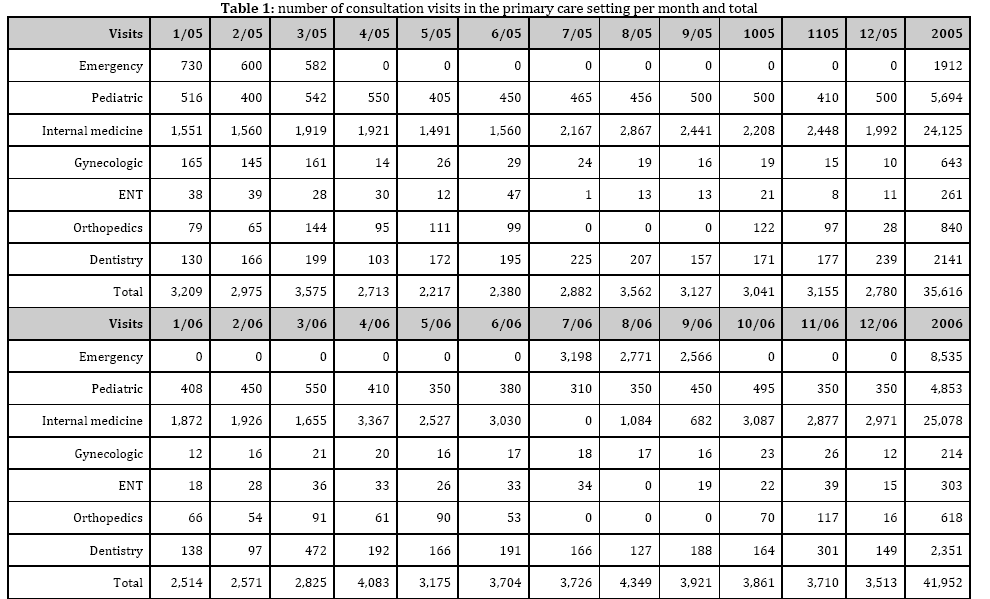
As we see in Table 2, complete blood count analyses accounted for the 8.95% of the total number of laboratory tests performed in 2005 and for the 17.50% in 2006. A further exploration of the above tables revealed to a strong correlation between the month and the total number of visits (r=0.566, p=0.004). In Diagram 1 it is obvious that there is a peak in the total number of visits in March (3,575) and in August (3,562) in 2005 and during April (4,083) and August (4,349) in 2006. In the meantime there was a peak in the total number of diagnostic tests performed in May (7,290) and June (7,299) of the year 2005 and in March (7,727) and in August (7,007) of the year 2006.
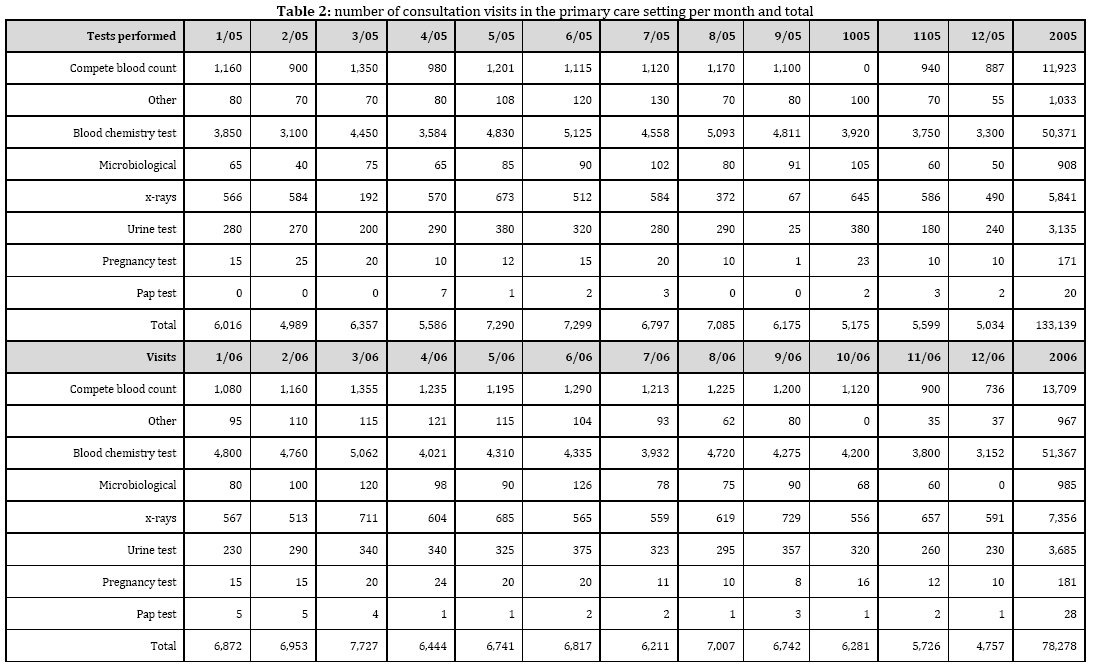
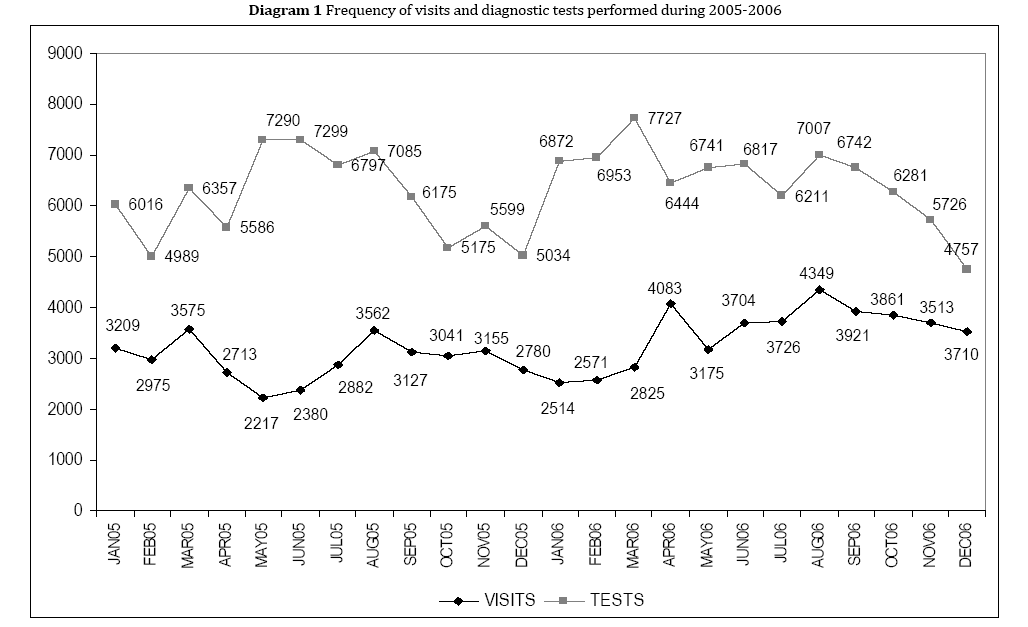
Diagram 1: Frequency of visits and diagnostic tests performed during 2005-2006
There was not a statistically significant correlation (r=-0.136, p=0.683) between the number of patients’ visits per month and the subsequent number of diagnostic tests performed.
T-test revealed to a statistical significant difference (p=0.020) between the year and the mean number of visits. More precisely the year 2006 the mean number of visits in the Health Centre was bigger (595.552±171.921) than that of the year 2005 (411.483±118.785). The analysis did not show a similar statistical difference between the year and the mean number of diagnostic tests performed the same period of time.
Projection of future use of primary care services and subsequent use of diagnostic tests
For the prediction of future use of primary health care services we used the Brown method. The analysis showed that the mean standard deviation of the predicted values from the real values was 370 and RMSE=484 visits. The mean error was 11.30% between 361 and 474 visits.

This means that the total number of patients’ visits for the year 2007 will range between 28,578 to 35,859. Diagram 2 shows the distribution of the visits for each month.
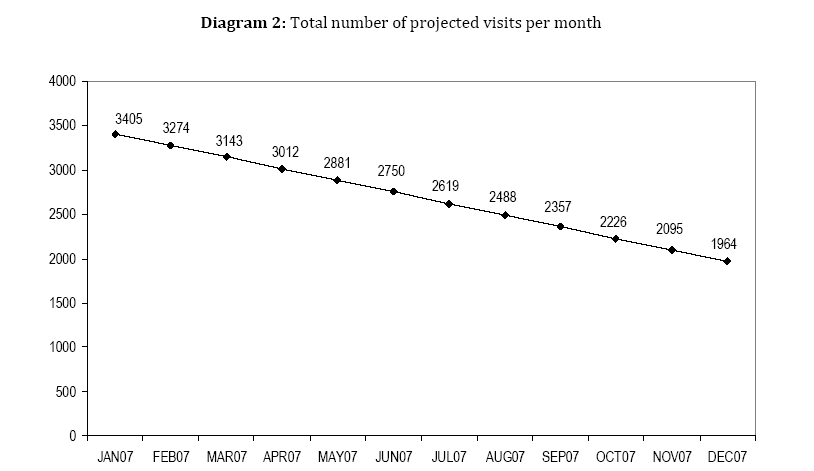
Diagram 2: Total number of projected visits per month
In order to predict the total number of projected diagnostic tests we have used the mathematical type:
Whereas SA is the seasonal index. Table 3 presents the total number of projected diagnostic test to be performed in the year 2007. According to our estimation the total number of diagnostic test will be 76,207 with a monthly range from 7,600 tests on March to 7,145 on August.
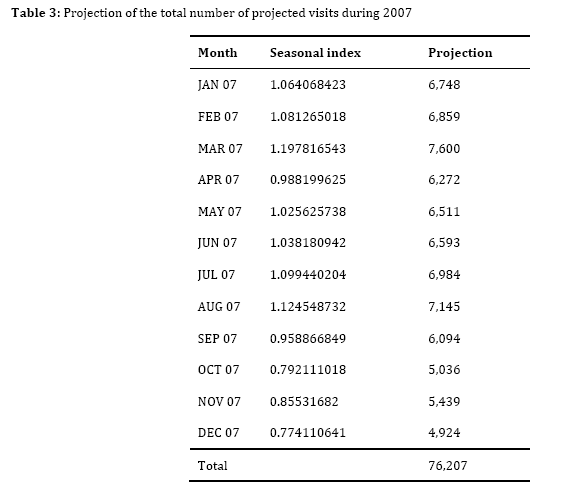
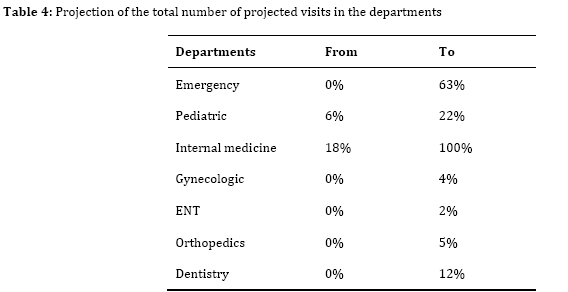
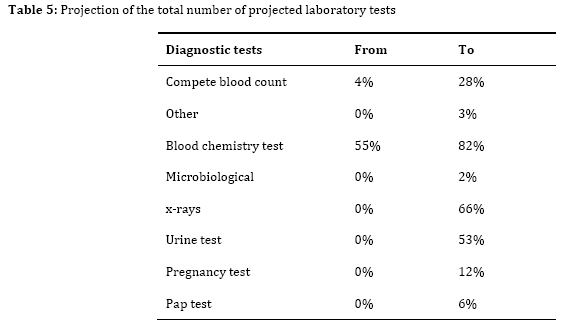
To predict the future use of health care services on the basis of a medical specialty our analysis followed the t student distribution because we had few observations (n<30). We concluded that the predicted number of visits in the paediatric department will range from 6% to 22% as opposed to the ENT that will range from 0% to 2%. The prediction for the internal medicine department has a wide deviation.
Discussion
This study provides information regarding visitation in a large urban primary health care centre. Before assessing and interpreting the findings of the present study, there are concerns that should be discussed. The sample of the present study is a convenient one and the selection of the data was made within a period of two years and therefore the prediction model may not reflect changes in the demographic characteristics of the sample. On the other hand we assumed no systematic variation in disease prevalence associated with utilization rates. Factors usually associated with high utilization include patient demographics, previous use of health care, patient diagnosis, and severity of illness [14]. Therefore we are not raising any claims that the sample is representative of the use of primary care services. Nevertheless, the results are representative of the use of services on North West Greece as the specific health care covers the major geographic regions of North West Greece.
According to the results there was an increase in the total number of primary care visits during 2006 (17.5%) compared with the year 2005. This could possibly reflect the increased preference of primary care services from the citizens, instead of outpatient hospital services. On the other hand it could be attributed to the large number of patients migrated outside of their service areas for care. According to our results a significant excess of utilization of curative and preventive public health care services was observed during summer months compared to the other months. This is a common finding in the literature [13] and is partially attributed to the increase of population in the summer period as many people visit their place of birth during their summer vacancies. Furthermore the health care centre was cited in a Greek region familiar to the tourists. In addition visits in the emergency department during 2006 for acute care and injury were more frequent and is attributed to the increase population who live in the rural areas of the North West Greece [15].
Better management of persistent primary care use may better address the patients' underlying problems, reduce unnecessary demand, and relieve some of the pressure on the capacity of primary care providers to deliver care to all patients. This study demonstrates the importance of augmenting primary health care centers with qualified nursing and medical staff and supplies in residential areas during the summer to cope with the situation and of providing proper and adequate primary care services. More health education is needed to inform people about importance of preventive primary care services for better utilization of the available services (13). Family practice training programs that prepare nurses and physicians for rural areas need to provide greater emphasis on care of infants and children than do urbanfocused programs [15].
General internal medicine services were mainly provided to the users. In a similar research in a Greek health centre in Koropi these cases were the second cause of visitation with the accidents were the first cause [10]. In another research in the Velestine Greek health centre a large number of internal medicine services were provided [11].
The low visitation rates to the gynecology department shows that women prefer to visit their private gynecologist. A similar research that tried to interpret this finding explained that women select their gynecologist after consultation from a relative or a friend [14].
Our estimates for the visitation rates during 2007 show an increase during the brumal season (January, February and March). This projection could be possibly attributed to the climatic conditions during this season and to the geographic distinctiveness given the massifs [15].
3678
References
- Primary health care: a framework for future strategic directions. Geneva, World Health Organization, 2003 (WHO/MNC/OSD/03.01)
- Filalithis Τ. Health for all 2000 and Primary Health Care: utopia, trap or a feasible shot? Iatriki 1982; 42(4): 257-264
- Dean SC, Harper CE, Cappuccio FP, Rink E, Dirckx C, Arnout J, Zito F and Iacoviello L on behalf of the European Collaborative Group of the IMMIDIET Project. The challenges of cross-national research in primary health care across Europe. Family Practice 2005; 22: 341-346
- Raftopoulos V. Beliefs, knowledge and attitudes of community-dwelling Greek elders towards influenza and pneumococcal vaccination. The Internet Journal of Epidemiology 2007 (under publication)
- Thom D, Kravitz R, Kelly-Reif S, Sprinkle R, Hopkins J, Rubenstein L. A new instrument to measure appropriateness of services in primary care. International Journal for Quality in Health Care 2004; 16:133-140
- WHO: Health services in Europe WHO Regional office for Europe Copenhagen, 1981
- Buciuniene I, Blazeviciene A, Bliudziute E. Health care reform and job satisfaction of primary health care physicians in Lithuania. BMC Family Practice 2005, 6:10
- WHO Regional office for Europe: Health 21: The health for all policy framework for the WHO European Region Copenhagen 1996
- Tsatsaris A, Filioussi K, Bonovas S, Mariolis A, Bellos G. Use of health services ath the emergency departments of Health Centre of Koropi. Medical Annual 2003; 26(9):433-437 (in Greek)
- Chatzikiriakos A, Vardoulis A, Filalithis A. Health promotion, use of health care services and satisfaction with health care services provided from the health centre of Velestino. Medical Annual 2003; 26(3): 170 -179 (in Greek)
- Raftopoulos V. Pain, satisfaction with quality of pain management and depressive symptoms in elderly hospitalized patients. ICU Nursing Web Journal. 2005;20
- Mahfouz AA, Hamid AM. An epidemiologic study of primary health care service utilization of summer visitors to Abha, Asir, Saudi Arabia. Journal of Community Health 1993; 18(2):121-125
- Naessens J, Baird M, Van Houten H, Vanness D, Campbell C. Predicting Persistently High Primary Care Use. Annals of Family Medicine 2005;3(4):324-330
- Probst J, Moore C, Baxley E, Lammie J. Rural-Urban Differences in Visits to Primary Care Physicians. Family Medicine 2002; 34(8):609-15.













